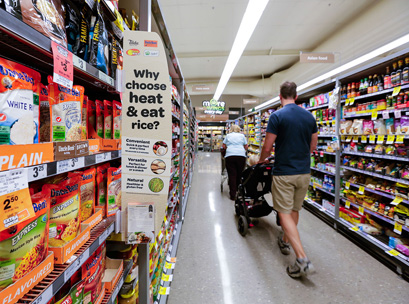 The Australian Bureau of Statistics (ABS) reported a flat month for retail trade over July after several months of 0.4 per cent growth.
The Australian Bureau of Statistics (ABS) reported a flat month for retail trade over July after several months of 0.4 per cent growth.
“There were falls in three of the six industries,” ABS director of quarterly economic wide surveys Ben James said. Household goods retailing fell by 1.2 per cent, while clothing, footwear and personal accessories fell by 2 per cent, and department stores dropped 1.9 per cent.
The drops were offset by increases in food retailing, which saw a 0.3 per cent increase, while cafes, restaurants and takeaway food services rose by 0.6 per cent, and “other” retailing – made up of recreational goods, pharmaceuticals, cosmetic and toiletry, and
newspaper and book retailing – jumped 1.7 per cent.
“There’s no need to hit the panic button just yet, but the July figures released by the ABS are certainly very ordinary,” National Retail Association chief executive Dominique Lamb said. “Retail had enjoyed three consecutive months of growth, so it is very disappointing to see the figures flatline for July.”
Lamb also commented on the upcoming state elections in both Victoria and New South Wales, as well as a federal poll to be held before May 2019.
“We know people spend less during election periods due to the uncertainty, so we can’t get complacent with the Christmas trade period just around the corner,” she said.
Australian Retailers Association executive director Russell Zimmerman noted that, while the month of July didn’t contribute much,
total growth year-on-year reached 2.89 per cent.
Specialised food drove the bulk of this increase, with a 5.7 per cent growth year-on-year, and liquor jumping 3 per cent.
“Although the latest Roy Morgan Net Trust Score survey revealed the most trusted industry is the retail sector, retailers still need a consumer confidence boost,” Zimmerman stated.
“July is always a tough month for fashion retailers because their winter stock slows down and their summer stock hasn’t had enough time to gain traction.”
Zimmerman noted that retail can only survive with increased business and consumer confidence, which is driven by personal tax cuts and a strong and stable Government.
Seasonally adjusted, only Queensland saw retail turnover rise (0.8 per cent), while New South Wales sat unchanged. Western Australia and the Australian Capital Territory fell by 0.6 per cent, while Tasmania and South Australia fell by 0.3 per cent and Victoria dropped 0.2 per cent. The Northern Territory’s turnover fell the farthest, decreasing by 1.6 per cent.





